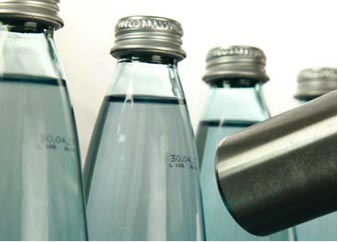Flying Ink Drops: Printing 2000 Products per Minute
Press release from the issuing company
Label & Print 2018 in Zurich: Leibinger is presenting the JET3up industrial inkjet printer (Hall 4, Stand H14)
Tuttlingen, Germany – At a bottling plant, a mineral water bottle speeds along a conveyor belt moving at 36 km/h. A few milliseconds later, the best-before date appears as if by magic on the bottleneck. This is made possible by Leibinger’s JET3up industrial inkjet printer, which prints up to 2000 products per minute with flying drops of ink.
Information such as best-before date, batch number and data matrix codes have become an integral part of most products. You can find the small letters and graphics on water bottles, milk cartons and beverage cans, on printed circuit boards for computers and on transparent medication packaging. If manufacturers call back batches, this information needs to be easy to read for consumers – smudged fonts cannot be tolerated by a manufacturer. The challenge is to guarantee imprint quality even at high line speeds.
The JET3up prints products that speed by at 36 km/h
At the Label & Print 2018 trade fair in Zurich (11.-12. April 2018), Leibinger will be showcasing the JET3up – an industrial inkjet printer that keeps up with belt speeds of 600 meters per minute. “The printer is fast enough to mark up to 2000 products per minute in passing,” explains Christina Leibinger, CEO of Paul Leibinger GmbH & Co. KG. “In spite of these high belt speeds, an exceptionally good typeface quality is guaranteed."

The JET3up in operation: the ink drops fly out of the print head, directly onto the product. They dry in less than a second.
The JET3up is used, for instance, in the food and beverage industry, in electronics and cable production, and in car manufacturing facilities. It can print not only up to five-line small fonts, but also graphics, barcodes and all common data matrix codes with a print height of up to 16 mm. Operation is via a 10.4” touchscreen that is as intuitive to use as a smartphone. If the user integrates the printer into the company network, he or she can control the machine from literally any point on the globe and monitor it with a PC, smartphone or tablet.
The principle of flying ink drops
The JET3up prints without having to touch any products. How is this possible? With a cylindrical print head mounted next to or above the conveyor belt – with which a head pipe of up to ten meters in length is connected to the hydraulic system in the printer housing. The heart of the so-called continuous-injection (CIJ) technology works inside the print head. 120,000 electrically charged ink drops per second shoot through a nozzle in the direction of a collecting tube. When printing, two deflection electrodes come into play. They change the trajectory of individual drops, so that they land as an image point or pixel on the product surface. The remaining drops fly into a catcher tube and circulate in the system.
Printing 160 million characters with one liter of ink
Non-contact printing always produces good results – with convex and concave, rough and smooth, flat and relief-like product surfaces alike. Smudging is ruled out since the ink dries on glass, plastic, metal, steel and wood in less than a second. The JET3up is also economical in consumption. One liter of ink is sufficient for printing up to 160 million characters.
Leibinger’s CIJ printers are considered to be the most reliable in the world. This is ensured, among other things, by Leibinger’s unique Sealtronic nozzle sealing system. “With many CIJ print heads, the nozzle and catcher tube remain open when the printer is out of service or in standby mode. The ink dries up, the nozzle clogs, so that the next time it starts up, it can lead to a diffuse spluttering or ink and an indistinct typeface,” explains Christina Leibinger. “This is not the case with Leibinger. With our patented Sealtronic sealing system, the catcher tube moves to the nozzle during production breaks and seals the system airtight. When re-starting, the typeface is instantly clear and stable – without cleaning and rinsing cycles, production starts again immediately. This is a must in any efficient production environment.”
© 2025 WhatTheyThink. All Rights Reserved.













